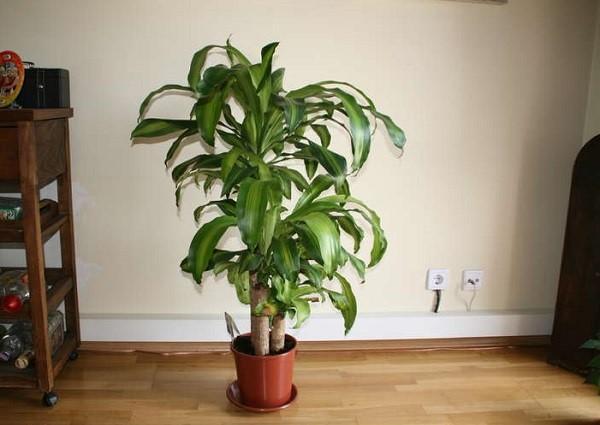Features of growing fragrant dracaena
 Fragrant dracaena is one of the most beautiful flower varieties. This species includes many varieties that differ in leaf color and bush height. Individual plants sometimes exceed 3 m in height, although there are also compact, no more than 50 cm, bushes.
Fragrant dracaena is one of the most beautiful flower varieties. This species includes many varieties that differ in leaf color and bush height. Individual plants sometimes exceed 3 m in height, although there are also compact, no more than 50 cm, bushes.
Depending on the variety, leaf plates can be either plain green or with multi-colored stripes. Bushes covered with green long leaves with white and yellow stripes look very beautiful. By the way, the length of the leaf plate reaches 30 cm.
Under natural conditions, fragrant dracaena grows up to 6 meters and blooms with fragrant inflorescences.
What does fragrant dracaena like?
In order to fragrant dracaena was actively growing and pleasing the eye with its bright green leaves, she needs to provide the following conditions:
- Nutrient soil... The best palm substrates are available from flower shops. Or mix in equal parts leaf and turf soil, peat and humus, as well as a little sand.
- Moderate lighting... It is necessary to avoid places that are too sunny so that there are no burns on the leaves, but in winter, put the flower closer to the windows. Once a month, the pot with the plant should be turned towards the sun with the opposite side so that dracaena (photo) grew even and did not bend.
- Comfortable temperature... In winter, during the dormant period, 15 degrees is enough for the plant, but the rest of the time the temperature in the room should be from 18 to 25 degrees Celsius (but not higher).
- Regular watering and spraying... In summer, dracaena should be watered twice a week, and in winter, once is enough. To clean the leaves from dust, you need to spray them or wipe them with a wet sponge.
- Timely feeding... The flower needs additional nutrition only from spring to autumn. During watering, add special complex preparations for dracaena or decorative deciduous plants to the water.
- Periodic transplants... Young bushes need to be replanted every two years, and adults - after five years, each time increasing the diameter of the pot by 4 cm.
Drying and dropping of the lower leaves indicates a lack of moisture, and the appearance of small insects (multitails) in the soil indicates excessive watering.
So that the dracaena does not look like a long stick with leaves at the top, it must be shaped in time. This is done by pinching or trimming the top of the bush. Thus, the awakening of dormant buds is stimulated, from which lateral shoots will begin to develop.
The cut off top of the dracaena can be rooted and a new plant can be obtained.
Reproduction of fragrant dracaena
Besides the top, the plant can be propagated directly by the side shoot. If there are a lot of them on the bush, with a sharp knife, so as not to damage the main trunk, carefully cut one or more shoots. Before rooting, dry the cutting well, leaving it on the windowsill for at least three hours.
Put the dried shoot in a container with water, and when roots appear on it (after about three weeks), plant it in loose and nutritious soil.
Dracaena has the strongest - the main shoot. It forms many leaves along the entire length of the stem and inhibits lateral shoots, in which the leaves are formed at the top, and the lower part is mostly naked.